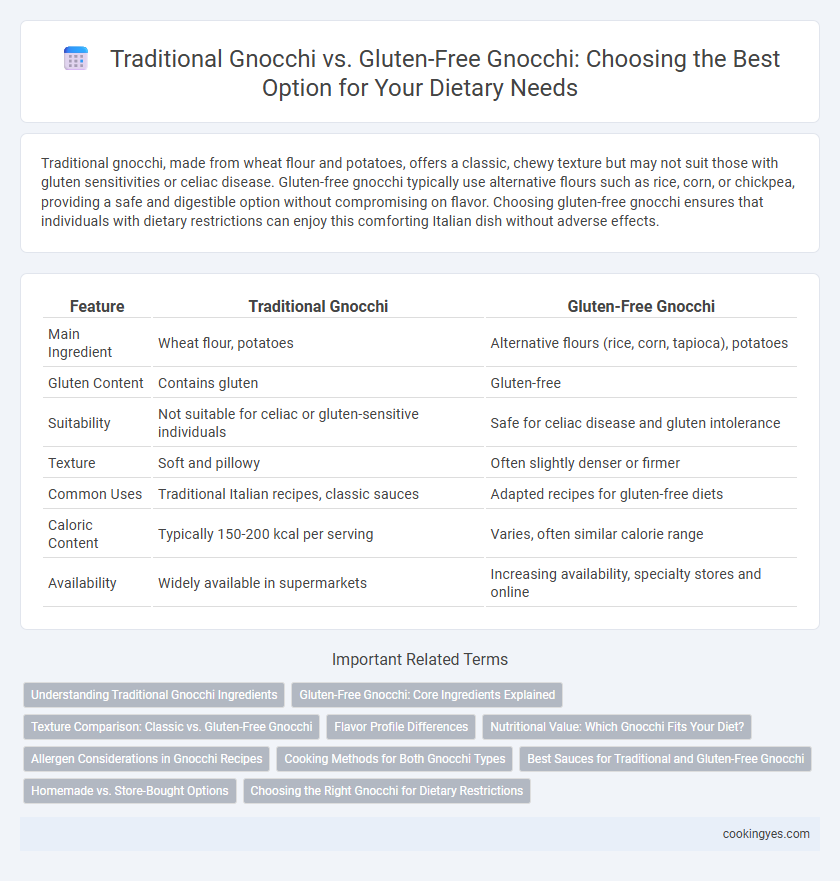Traditional gnocchi, made from wheat flour and potatoes, offers a classic, chewy texture but may not suit those with gluten sensitivities or celiac disease. Gluten-free gnocchi typically use alternative flours such as rice, corn, or chickpea, providing a safe and digestible option without compromising on flavor. Choosing gluten-free gnocchi ensures that individuals with dietary restrictions can enjoy this comforting Italian dish without adverse effects.
Table of Comparison
| Feature | Traditional Gnocchi | Gluten-Free Gnocchi |
|---|---|---|
| Main Ingredient | Wheat flour, potatoes | Alternative flours (rice, corn, tapioca), potatoes |
| Gluten Content | Contains gluten | Gluten-free |
| Suitability | Not suitable for celiac or gluten-sensitive individuals | Safe for celiac disease and gluten intolerance |
| Texture | Soft and pillowy | Often slightly denser or firmer |
| Common Uses | Traditional Italian recipes, classic sauces | Adapted recipes for gluten-free diets |
| Caloric Content | Typically 150-200 kcal per serving | Varies, often similar calorie range |
| Availability | Widely available in supermarkets | Increasing availability, specialty stores and online |
Understanding Traditional Gnocchi Ingredients
Traditional gnocchi are primarily made from potatoes, wheat flour, and eggs, providing a soft texture and mild flavor but containing gluten that may trigger sensitivities. Gluten-free gnocchi substitute wheat flour with alternative flours like rice, almond, or chickpea, catering to those with gluten intolerance or celiac disease while maintaining a similar consistency. Understanding the classic ingredients helps distinguish the dietary implications and guides appropriate choices for gluten-free diets without sacrificing traditional taste.
Gluten-Free Gnocchi: Core Ingredients Explained
Gluten-free gnocchi are typically made from alternative flours such as rice flour, potato starch, or tapioca flour, which replace wheat-based ingredients to accommodate gluten intolerance or celiac disease. These core ingredients maintain the soft, pillowy texture characteristic of traditional gnocchi while ensuring the dish remains safe for gluten-sensitive individuals. The use of naturally gluten-free components highlights the versatility and inclusivity of gnocchi in diverse dietary needs.
Texture Comparison: Classic vs. Gluten-Free Gnocchi
Traditional gnocchi, made from wheat flour and potatoes, offers a soft, pillowy texture that balances chewiness and lightness, providing a satisfying mouthfeel. Gluten-free gnocchi, often crafted from alternative flours like rice, corn, or cassava, can vary in texture, sometimes resulting in a denser or slightly grainier bite due to the absence of gluten's elasticity. Texture preferences for classic versus gluten-free gnocchi depend on balancing softness and structural integrity, critical for meeting diverse dietary needs without compromising culinary experience.
Flavor Profile Differences
Traditional gnocchi, made with wheat flour, offers a soft, pillowy texture and a mild, slightly sweet flavor that easily absorbs savory sauces. Gluten-free gnocchi often use alternative flours like rice, potato, or chickpea, resulting in a denser texture and a nuttier, earthier taste that can alter the overall dish experience. Flavor profiles diverge notably due to different base ingredients, making traditional gnocchi creamier while gluten-free versions emphasize distinct grain or legume notes.
Nutritional Value: Which Gnocchi Fits Your Diet?
Traditional gnocchi, made from wheat flour and potatoes, provides a moderate amount of carbohydrates and protein but contains gluten, which can be problematic for those with celiac disease or gluten sensitivity. Gluten-free gnocchi typically use alternatives like rice flour, corn starch, or chickpea flour, offering comparable calories but often higher fiber and protein levels, catering to gluten-intolerant individuals. Choosing between traditional and gluten-free gnocchi depends on dietary restrictions, with gluten-free options enhancing nutrient absorption and digestive comfort for sensitive diets.
Allergen Considerations in Gnocchi Recipes
Traditional gnocchi, typically made from wheat flour and potatoes, contains gluten, posing a risk for individuals with celiac disease or gluten sensitivity. Gluten-free gnocchi recipes often substitute wheat flour with alternatives like rice flour, tapioca starch, or chickpea flour, reducing allergen exposure while maintaining texture. Selecting gluten-free gnocchi is essential for those with allergen concerns, ensuring safe consumption without compromising on taste or mouthfeel.
Cooking Methods for Both Gnocchi Types
Traditional gnocchi, made with wheat flour and potatoes, requires boiling until they float, signaling they are cooked through and tender. Gluten-free gnocchi, often prepared with alternative flours such as rice or cassava, typically follow a similar boiling process but may need gentler handling to prevent breakage due to their delicate texture. Both types benefit from lightly pan-frying after boiling to enhance flavor and achieve a crispy exterior without compromising the soft interior.
Best Sauces for Traditional and Gluten-Free Gnocchi
Traditional gnocchi, made from wheat flour and potatoes, pairs exceptionally well with rich sauces like classic marinara, creamy Alfredo, and browned butter sage, enhancing its soft, pillowy texture. Gluten-free gnocchi, crafted from alternative flours such as rice, corn, or chickpea, requires lighter sauces like fresh tomato basil, garlic and olive oil, or lemon herb to complement its slightly different texture without overpowering it. Selecting sauces rich in fresh herbs, garlic, and subtle acidity helps optimize flavor profiles for both traditional and gluten-free gnocchi varieties.
Homemade vs. Store-Bought Options
Traditional gnocchi, typically made from wheat flour and potatoes, offers a soft texture and classic flavor but may not suit those with gluten sensitivities or celiac disease. Gluten-free gnocchi, often crafted from alternative flours like rice or chickpea, provides an essential dietary option, especially when homemade to ensure no cross-contamination and fresh ingredients. Store-bought gluten-free varieties offer convenience but can vary in texture and ingredient quality, making homemade versions superior for tailored dietary needs and optimal freshness.
Choosing the Right Gnocchi for Dietary Restrictions
Traditional gnocchi, made primarily from wheat flour and potatoes, contains gluten, making it unsuitable for individuals with celiac disease or gluten intolerance. Gluten-free gnocchi alternatives often use rice flour, corn flour, or a blend of gluten-free starches to maintain the soft texture while accommodating dietary restrictions. Selecting the right gnocchi involves checking ingredient labels carefully to ensure compliance with specific dietary needs and avoiding cross-contamination risks.
Traditional gnocchi vs gluten-free gnocchi for dietary needs Infographic

 cookingyes.com
cookingyes.com